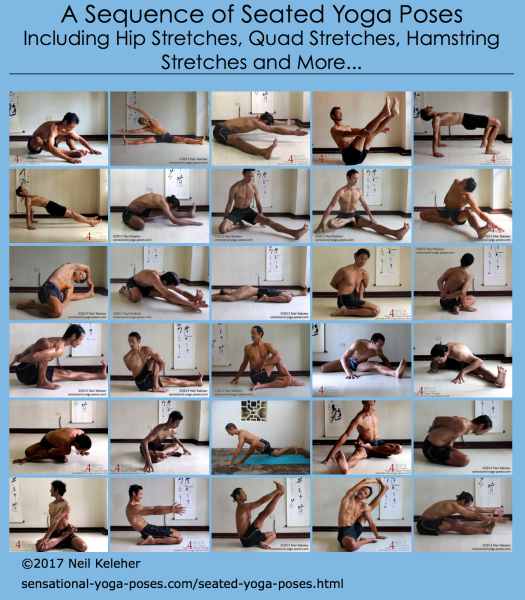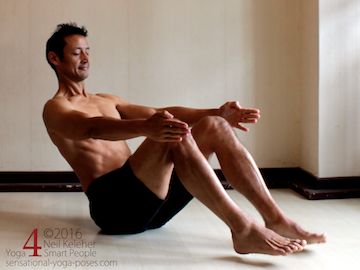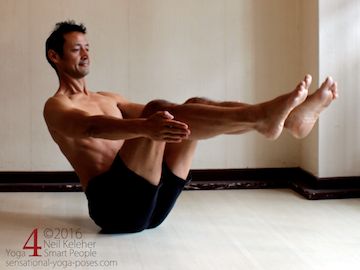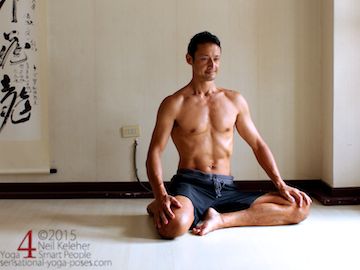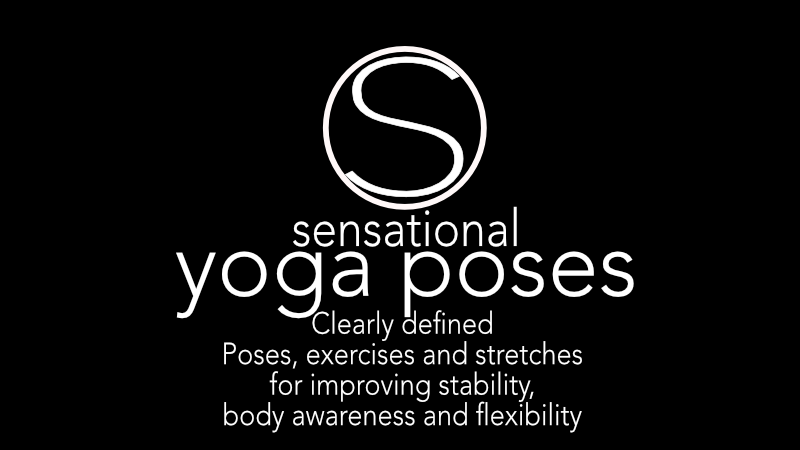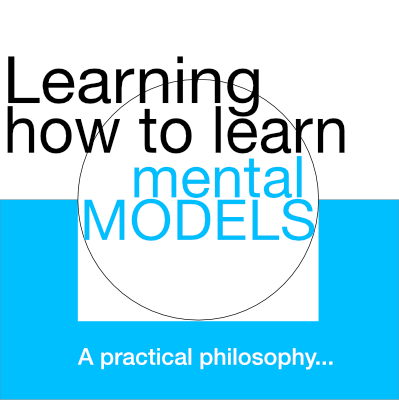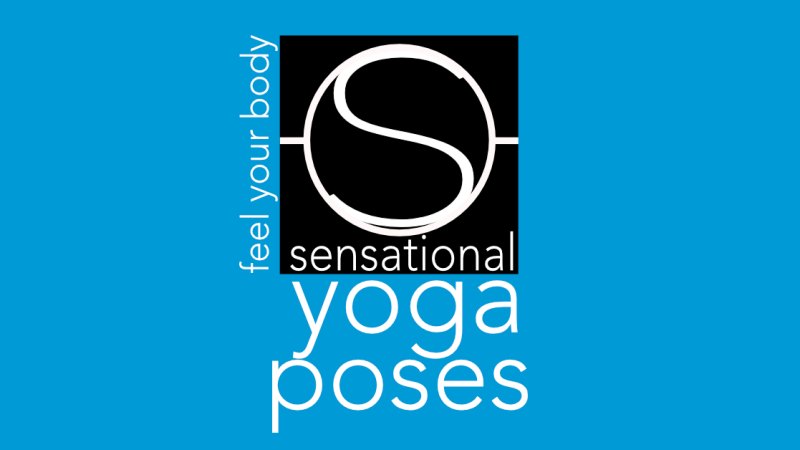Seated Yoga Poses
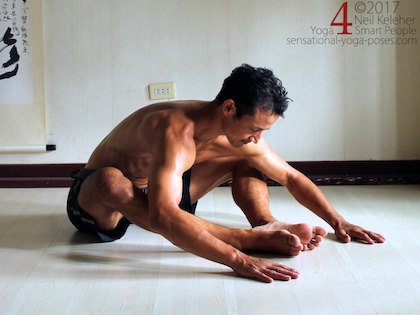
Bound Angle
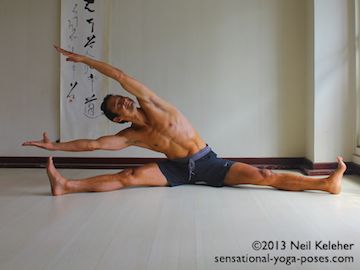
Wide leg side bend
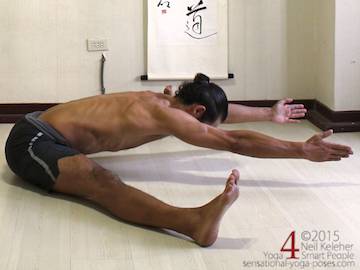
Wide leg forward bend
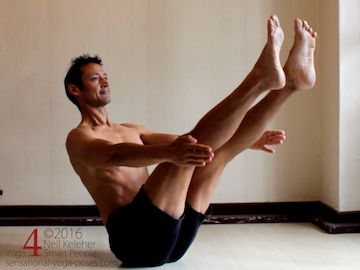
Boat pose
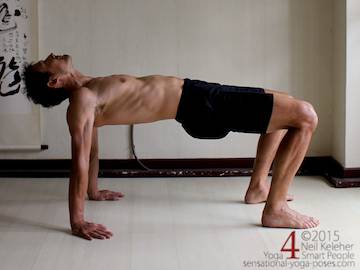
Table top

Reverse plank

Janu sirsasana A
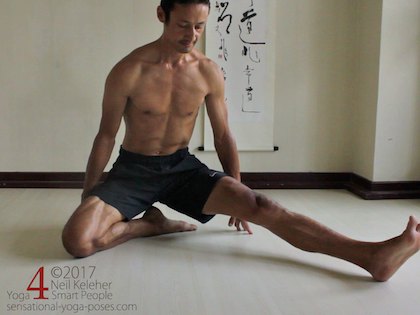
Janu sirsasana B
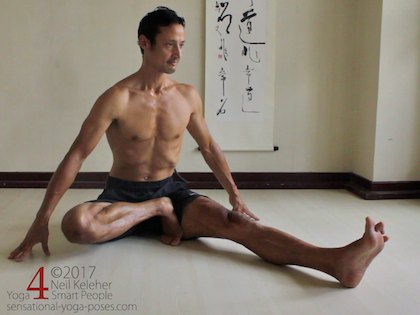
Janu sirsasana C
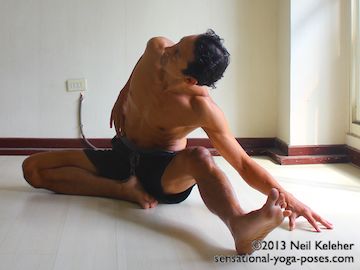
Janu sirsasana Side bend
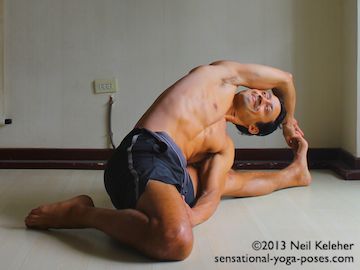
Half hero side bend
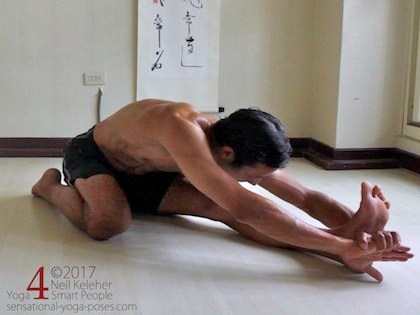
Half hero forward bend
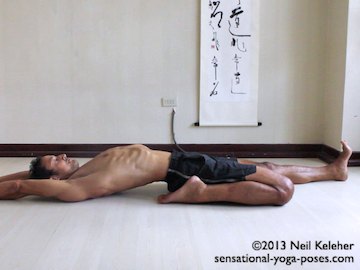
Half hero backbend
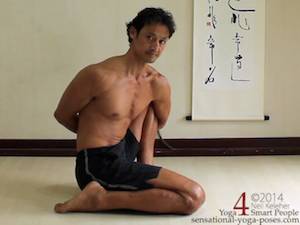
Marichyasana E
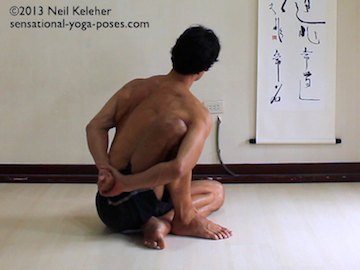
Easy Marichyasana B
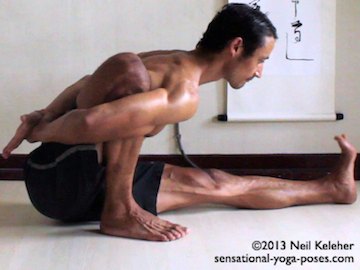
Marichyasana A
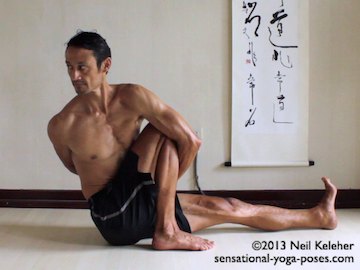
Marichyasana C
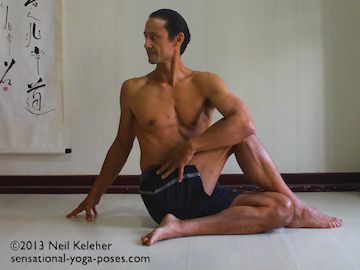
Ardha matsyendrasana
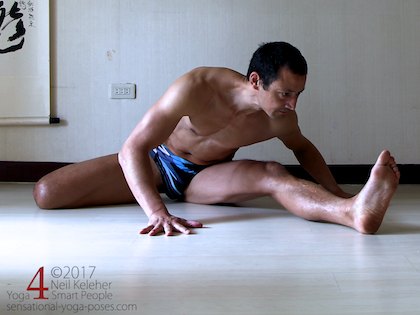
Hurdler's stretch
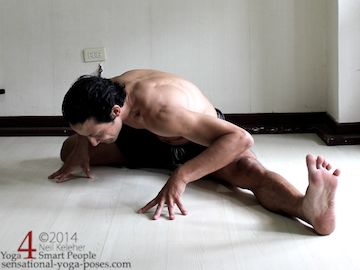
Hurdlers stretch variant (frog pose)
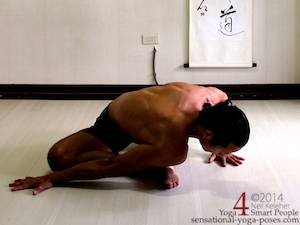
Intense pigeon

Square pigeon
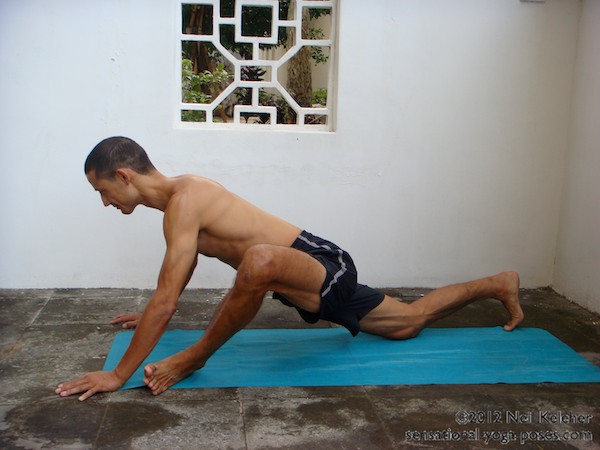
Lunge variant as lotus prep
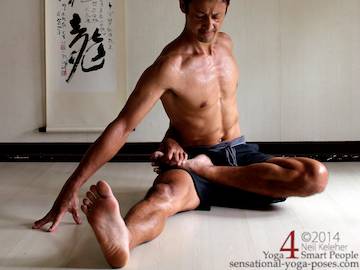
Half bound lotus
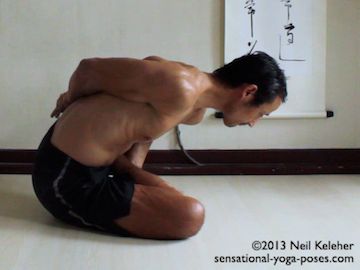
Marichyasana B
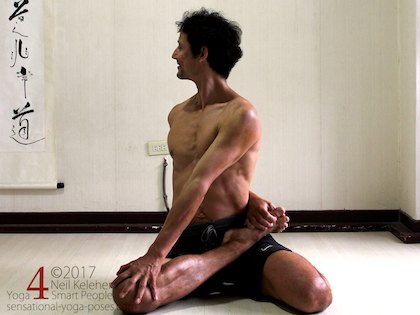
Bharad vajasana
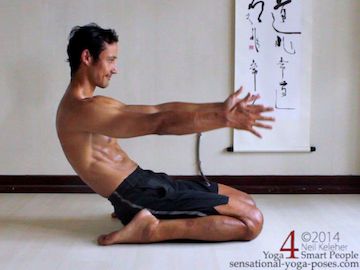
Reclining hero
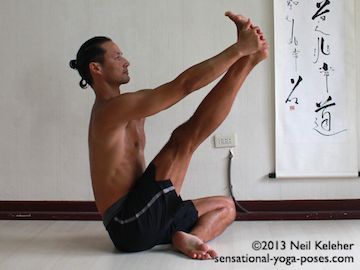
Compass prep/heron variant
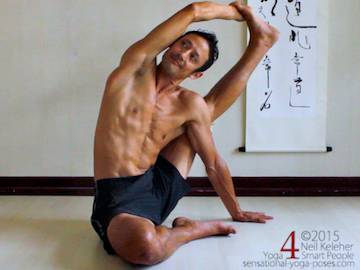
Compass pose
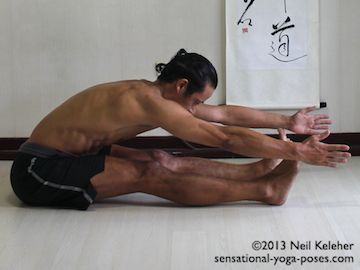
Forward bend
In Bound Angle Pose (baddha konasana) is a seated yoga pose both knees are bent with the feet together. You can sit upright in this pose or bend forwards.
- If you have your feet close to the pelvis this pose stretches the inner thighs.
- If you have your feet further forwards then this pose turns into a stretch for the outer thighs.
- For both positions try pushing your feet down into the floor.

Wide Bound Angle
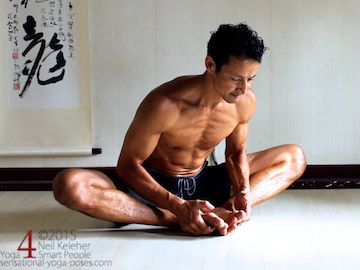
Bound Angle
If doing both variations (and bending forwards) you may find it easier to start with the "wider" variations, then do the variation with the feet closer to the hips.
While seated wide leg forward bend is a relatively easy forward bend (compared to bending forwards with feet together) it may be easier bend forwards if you first start with a side bend.
If you are less flexible
- Try bending your knees.
- You can also place the lowermost hand to the outside of the thigh if you find you are tipping backwards.
(And if you have trouble bending sideways and bending forwards in this seated yoga pose, you might want to do the standing version of this pose instead.)
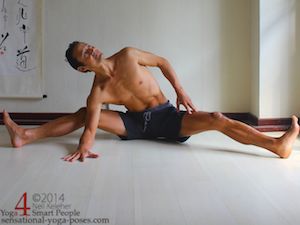
Wide Leg Side Bend With knees bent

Seated Wide Leg Side Bend
When bending to the side you can allow the hip on the side you are bending away from to lift. Or you can work at keeping it on the floor.
- If you allow the hip to lift your direct the stretch to the back of the leg you are bending towards.
- If you keep the hip down then you focus the stretch on your lumbar and thoracic spine as well as your shoulder if you are grabbing the foot over your head.
One option might be to start with the hip lifted, particularly if you are trying to grab your foot with the opposite hand.
Then, once you have grabbed your foot, the work at sinking the hip.
If you are doing this pose with the hands lifted, try pressing down against the floor with the leg you are leaning towards. Do this prior to reaching your hands.
To make it easier to reach your hands, reach your bottom hand first, pause, then reach your top hand.
If you want to work on getting your feet wider either before or after doing a side bend you might find it helps to focus on opening your hip creases. For more on how to do that (and thus stretch your adductors) read seated straddle splits
In Wide Leg Forward Bend, press your feet into the floor so that you can lift your hands. This will strengthen your hamstrings. To rest, put your hands on the floor then relax your hamstrings.
If you start with your hands close to your hips, lifting them is a little easier. You can lift them then slowly reach them forwards so that you gradually add to the work that your hamstrings and glutes are doing.
For boat pose, lean back so that your heels lightly touch the floor. Then:
- First try lifting your feet an inch off of the floor. Lower and repeat a few times.
- Then try lifting your feet so that your shins are parallel to the floor. Repeat a few times
- Then try it with knees straight.
So that you give your hips a chance to rest, first do boat pose lifting your feet a little. Then do table top. Then do boat pose with shins horizontal. Then do reverse plank. Then do boat pose with knees straight.
While seated it is easy to place your hands behind you and lift your pelvis up into table top to stretch the front of your hips and your shoulders.

Table Top
For reverse plank try frictioning your hands forwards prior to lifting your hips.
(For more on "Frictioning" read or view Frictional Muscle Control)

Reverse Plank
The janu sirsasana series of seated yoga poses can be used to stretch the hamstrings one leg at a time. They also work on the knee of the bent knee leg in different ways.
In janu sirsasana A place the bent-knee foot against the inner thigh of the straight-leg.
In the Janu sirsasana B variation sit with your anus on top of your heel.

Janu Sirsasana A

Janu Sirsasana B

Janu Sirsasana C
In the Janu Sirsasana C variation place the sole of the foot against the inner thigh with the heel uppermost and the ball of the foot on the floor. In this position the shin is folded to the inside of the thigh and is externally rotated. In comparison the same foot in janu sirsasana A is internally rotated.
Notice the similarity of the Janu Sirsasana C foot position to the half bound lotus seated yoga poses.
Because the bent knee foot can make it difficult for the same-side hip to lift, side bending in janu sirsasana can be a little bit more difficult than it is when side bending in the wide leg position. For this reason, if you want a more challenging side bend, then this seated yoga pose can be useful in that regard.

Janu Sirsasana Side Bend with knee bent
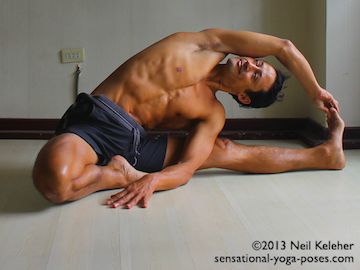
Janu Sirsasana Side Bend
To make the side bend easier, you can bend the knee of the leg your are bending towards.
The janu sirsasana series of poses could be thought of as externally rotated hip positions for the bent knee. That being said, the shin can be internally rotated relative to the thigh in B position and externally rotated relative to the thigh in C position. Since B and C tend to counterpose each other with respect to shin rotation relative to the femur (aka knee rotation) we may find it helpful to counterpose the external hip rotation action of these three janu sirsasana poses with some poses that have the hip internally rotated.
In half hero side bend the legs are opened to 90 degrees with the bent knee folded in the hero position.
This seated side bend position may be easier that the janu sirsasana versionsince it the bent-knee hip is easier to lift.
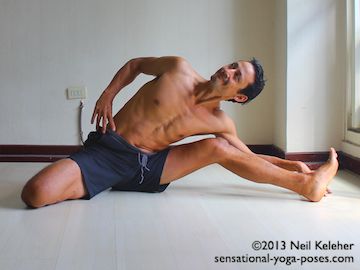
Knee Bent variant

Half Hero Side Side Bend
Note the bent knee modification.
If you can grab your foot with the knee bent, then try straightening the knee while holding onto the foot. Otherwise just reach the arm over the head, and take the supporting arm off of the floor so that you can work against the weight of your body.
In Half hero forward bend (Triang Muka Eka Pada Paschimottansana) try pressing down with the straight leg to stay balanced as you lean forwards in this seated yoga pose. Use it to push your weight towards the hero-leg side.
Reclining Half Hero is a nice way to stretch the quad and hip flexors of the bent knee leg.

Half Hero Forward Bend

Half Hero Quad Stretch
You might choose to do the forward bend first and then the quad stretch.
Or you can try the quad stretch first and then the forward bend.
Easier marichyasana seated yoga poses include variations where the non-marichyasana foot is in hero position or the basic janu sirsasana A position.
These are handy for learning to bind.

Marichyasana Hero Variation

Marichyasana Janu Variation
Of the two, the hero variation is probably the easier.
In both Marichyasana A and Marichyasana C the non-marichyasana leg is straight.
Generally the binding hand grabs the other hand but I'd suggest switching hands for a slightly different experience of these seated yoga poses.

Marichyasana A

Marichyasana C
Keep your neck long and make your arms feel long when preparing to bind.
Once you have bound you can try using your arm to press against the leg. You can also press your leg against the arm to add tension to the pose. This tension may help give the pose greater integrity.
In Ardha Matsyendrasana you can bind the hand or more traditionally, grab the foot of the upright knee with the arm along the outside of the thigh.
Once you are comfortable either grabbing the foot or binding, you can experiment with pressing the thigh against the arm while at the same time pressing the arm against the thigh.

Ardha Matsyendrasana
The picture above shows a modified or preparatory position with the arm hugging the knee. In this position you can still use both arms to drive the twist.
For Hurdlers Stretch you can bend towards the straight leg or bend forwards between the legs. This latter position may be known as Frog Pose.

Hurdlers Forward Bend

Frog Pose Variant
Incidentally, this pose can be used to balance the following pose, pigeon.
Postures that may help you move towards lotus include: pigeon pose glute stretch and double pigeon. Another pose you could use which is a variation of a low lunge is this glute stretch.

Intense Pigeon

Double Pigeon

Glute Stretch
While binding in half bound lotus seated yoga pose, you may find it helpful to twist away from the lotus leg. Once bound, then try facing forwards.
To keep your knee active (and safer) pull your foot forwards, as it trying to pull it away from your hand. At the same time pull your hand away from the foot.
Both your arm and leg should then feel active.

Twisting Away from Lotus Leg
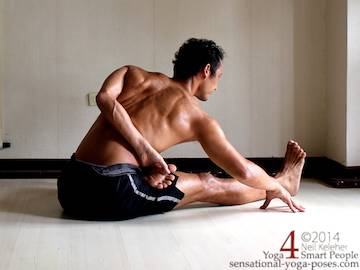
Bending Forwards
For standing one leg lotus forward bend read the ardha baddha padmasana article.
Once you can get your feet into lotus on one side you can then work towards full lotus (padmasana) seated yoga pose. I would suggest practicing both sides.
From an organ stimulation point of view, the left foot on top position (shown) is the preferred method since the left heel can then stimulate the liver and the left foot the stomach. The liver is higher than the stomach.
However, this will only happen if your lotus is very tight (the knees moving inwards and the heels pressing into the lower belly.)
In particular this happens when you bind both feet and/or bend forwards.
I don't practice lotus enough to offer an "expert" or "experienced" opinion and so ideally, try both options, notice the results and make your decision based on your own observations.
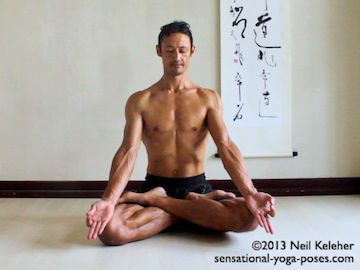
Lotus
In both Marichyasana B and marichyasana D the non-marichyasana foot is in the lotus position.

Marichyasana B
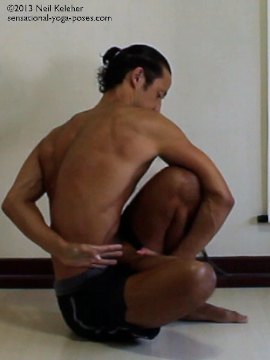
Marichyasana D (attempt)
Bharadvajasana has a leg in hero and a leg in lotus. And it's a twist. So it's "self balancing." It doesn't need a counterpose. It may be one of the easier "traditional" seated yoga poses with a lotus element simply because the torso is upright.
If you can't do the lotus foot position, then place the foot against the inner thigh in a modified bharadvajasana seated yoga pose.
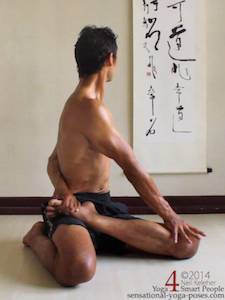
Bharadvajasana Seated Yoga Pose Twist
To counterpose the lotus element of the previous two marichyasana seated yoga poses, you could do hero pose (virasana). To help work towards reclining, try bent back hero and from there work towards reclining.
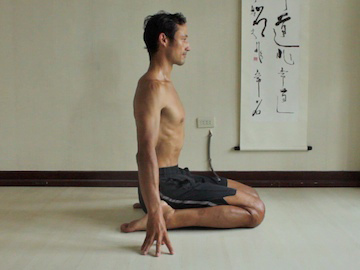
Hero Pose

Bent Back Hero
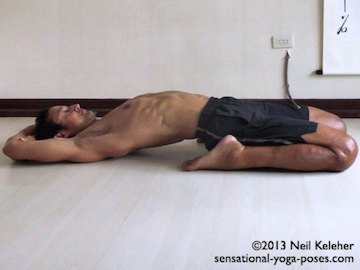
Reclining Hero Pose
Compass pose preparation is a seated hamstring stretch. It's a preparation for compass pose but also an easy way to do heron pose since the bent knee leg isn't in hero position.
In this seated yoga pose you can focus on relaxing your shoulders so that you can keep the hip joint decompressed You may find it easier then to pull the leg back.

Compass Pose Prep
In compass pose with the leg behind the shoulder, relax the shoulder of the grabbing hand until you get the knee straight. Then if you like pull the leg inwards. As you straighten the leg in compass pose, roll the leg so that the knee points towards the ribcage, like it does in either of the side bending yoga pose half hero side bend or janusirsasana side bend.

Compass Pose
This pose can be a good preparation for the arm balance eka pada kundinyasana.
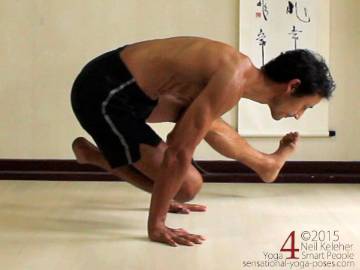
Eka Pada Kundiyasana Modified
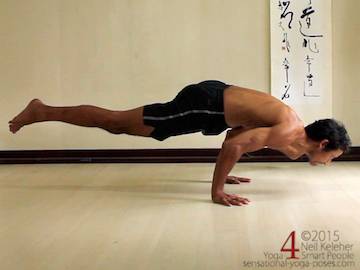
Eka Pada Kundiyasana
In Seated Forward Bend (Paschimottanasana) focus on creating an upward pull on your legs so that your quadriceps and hip flexors activate. Reach your arms forwards to add weight to the pose.
You could also bend forwards with legs crossed for an easy seated forward bend.

Seated Forward Bend
Reclining or Belly Up Poses
From seated poses, you could move next to reclining or supine yoga poses.
Published: 2017 09 13
Updated: 2021 01 24
